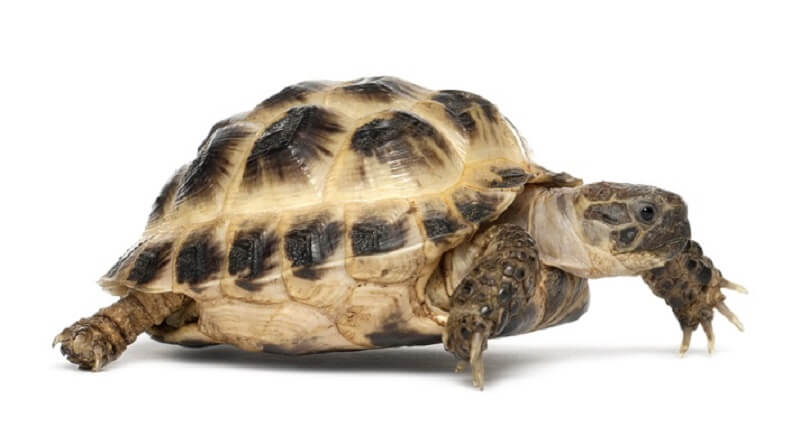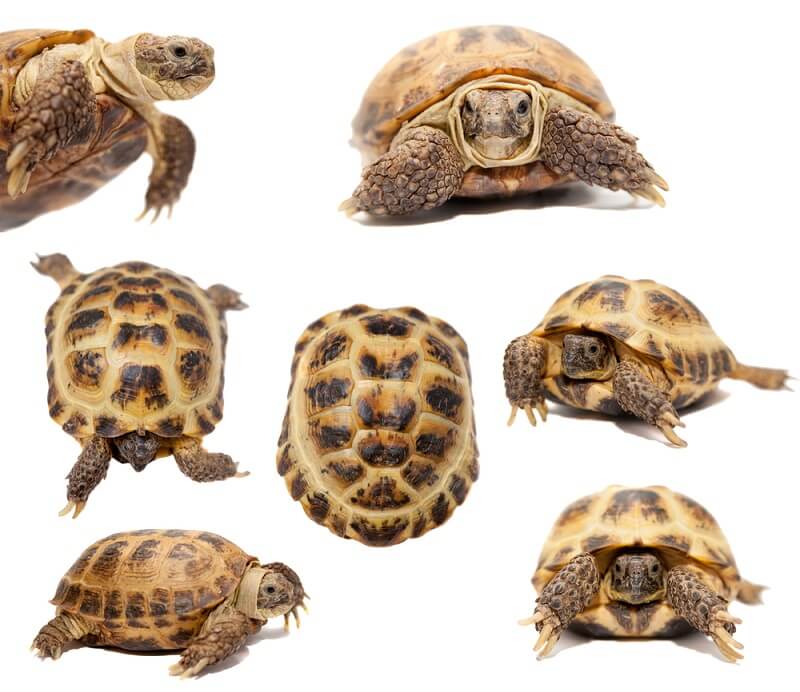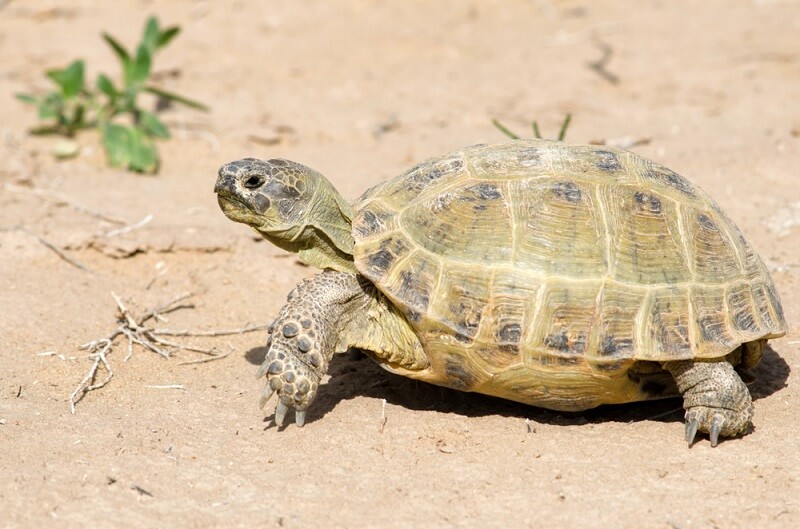
| Kingdom | Animalia |
| Phylum | Chordata |
| Class | Reptilia |
| Order | Testudines |
| Family | Testudinidae |
| Genus | Agrionemys |
| Species | Agrionemys horsfieldii |
| Niche | Roaming Desert Herbivore |
| Length | 5-10 in (13-25 cm) |
| Weight | Less than 5 lbs (2.2 kg) |
| Lifespan | Up to 100 years! |
| Social Structure | Solitary |
| Conservation Status | Vulnerable |
| Preferred Habitat | Arid regions of Russian and Central Asia |
| Average Clutch Size | 1-5 eggs |
| Main Prey Species | Vegetation, fruits, vegetables |
| Predators | Canines, felines, large predatory birds, and humans |
The Basics
The Russian tortoise is a species native to Russia and Central Asia. Also known as the Afghan tortoise, Horsfield’s tortoise, or the “four-clawed” tortoise, this species is well-adapted to arid desert environments and has a distinctive coloration on its shell. Typically, the tortoise is a light yellow color with distinctive black patches on the scutes of the shell. While the Russian tortoise is a commonly kept pet, it is classified as Vulnerable in the wild.
With a lifespan of up to 100 years, the Russian tortoise is one of the longest living species on the planet – a group known as “supercentenarians.” However, the Russian tortoise may hibernate for up to 9 months out of the entire year in regions that get cold for long periods of time. The tortoises emerge from hibernation in late spring, eat and reproduce in the summertime, and go back into hibernation for much of the year. In captivity, hibernation requirements can be much shorter – though hibernation may be important for the health of many reptile species and should not be skipped entirely.

Interestingly, Russian tortoises display a surprisingly complex mating ritual. Males will bob their heads, circle, and bite the forelegs of a female in an attempt to get her to mate. If she consents, she will stop trying to flee the male and will let him mount. Males may emit funny squeaking noises while mating and females will dig a nest shortly after to lay eggs in. Eggs must develop for 8-10 weeks before young tortoises emerge. Baby Russian tortoises retain a yolk-sac for a couple of weeks to help them get established before they must start eating regularly.
Interesting Insights from the Russian Tortoise!
Russian tortoises are commonly kept pets, but few owners realize just how amazing their pets actually are. In fact, Russian tortoises are amazing examples of several very important biological concepts.
Supercentenarian Lifespan
Only a handful of animals on the planet can live over 100 years. These organisms – supercentenarians – are present across many different animal families. While several massive animals such as whales and sharks are known to live well over 100 years, it is less common in smaller animals (though many microscopic organisms are technically “immortal”). However, the Russian tortoise is not the only small animal that can live over 100 years.
Other small supercentenarians include the tuatara, the bigmouth buffalo fish, lobsters, and several species of molluscs and worms. Though much more research needs to be done to understand how these species can live for so long, one prominent theory is related to the telomeres found on chromosomes. Telomeres are repetitive sections of DNA that are found on either end of a chromosome. It is thought that over time telomeres break down, leading to non-functional DNA when the telomere fully wears off. Research is currently being conducted to see if extended telomeres can add years of life to organisms that normally do not live long amounts of time.

Desert Adaptations
Desert animals have some of the most amazing adaptations because they live in an area devoid of life’s most important substance: water.
Russian tortoises, like many desert animals, must get most of the water they need through their food. By eating foods like lettuce, fruits, and vegetables, these tortoises are able to get enough water without ever having to drink water. These tortoises have many adaptations to make this possible. First, their digestive tract is better at absorbing water compared to species that live in more humid, wet areas. Plus, these turtles likely have adaptations in their kidneys that allow the kidneys to use less water to remove waste products from the bloodstream.
Other adaptations include a large, domed shell and fat stores that can store water for a long time. In fact, since these tortoises are known to hibernate for up to 9 months, their bodies must be able to store water for that entire duration. In captivity, depriving Russian tortoises of water is not necessary. They often enjoy being bathed in shallow, warm water on occasion. Plus, this will help your tortoise stay hydrated in case their diet does not contain enough water by itself.

Temperature-Dependent Sex Determination
Like many reptiles, the sex of a baby Russian tortoise is not determined by the chromosomes it inherited from its parents. Instead, males are formed when incubating temperatures are lower, whereas females are formed when the temperatures are higher. In the wild, nests are imperfect and have areas of high and low temperatures – leading to both males and females being born from the same nest. In captivity, eggs are typically incubated at specific temperatures – allowing breeders to control whether males or females are born.
While this is an awesome feature for reptile breeders who are trying to produce specific sex, species with temperature-dependent sex determination may experience challenges as the global climate changes and certain areas of the globe heat up. Essentially, if global warming continues, Russian tortoises will only be able to produce females and the species will die out. Other species that determine sex through the temperature eggs are incubated at include crocodiles, turtles, and many lizard species.
